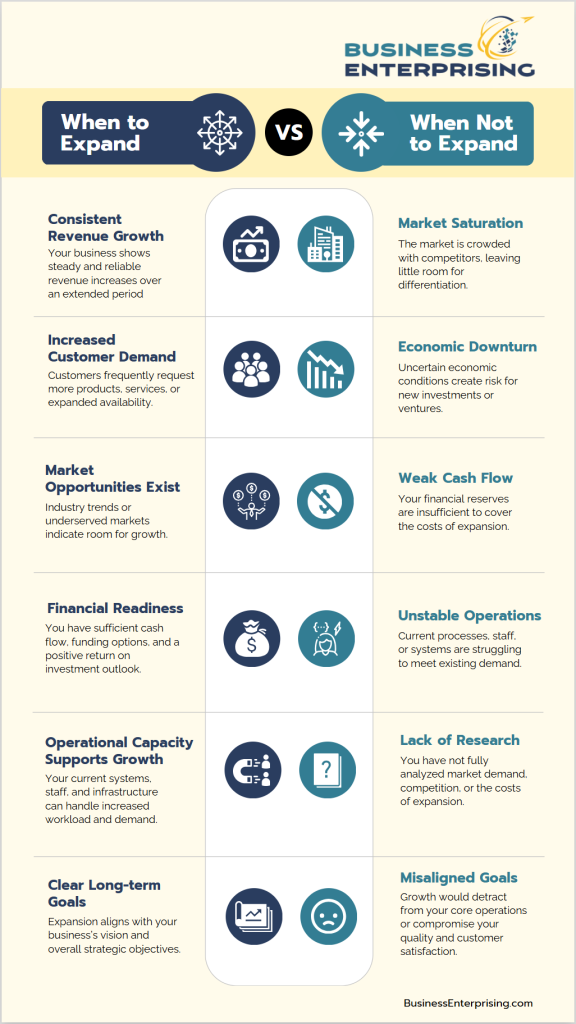
However, expanding too soon can strain your resources and jeopardize your progress. By taking a strategic approach, you can avoid common pitfalls and position your business for success. Additionally, evaluating both external opportunities and internal readiness helps you make more informed decisions. With careful planning, you can identify the right time to take your business to the next level.
Signs It’s the Right Time to Expand
Recognizing the right moment to expand your business is essential for sustainable growth. Consistent revenue growth and increased customer demand are strong indicators that your business may be ready to scale. When your sales figures rise steadily over time, it suggests a healthy market interest in your products or services. Additionally, if customers frequently request more offerings or extended services, it’s a clear sign of unmet demand. Therefore, monitoring these trends can help you determine when to expand your business.
Assessing market opportunities and industry trends is also crucial. A growing industry indicates potential for business expansion. By staying informed about your sector’s dynamics, you can identify favorable conditions for growth. Therefore, conducting thorough market research and analyzing industry reports can provide valuable insights. This proactive approach ensures that your expansion efforts align with current market demands and future projections.
However, it’s important to balance enthusiasm with caution. While positive indicators suggest readiness, expanding prematurely can strain resources. Therefore, ensure that your business infrastructure can support growth before making significant changes. By carefully evaluating both internal performance and external market conditions, you can make informed decisions about when to expand your business.
Evaluating Your Financial Readiness
Evaluating your financial readiness is essential when deciding when to expand your business. Understanding the costs involved is a critical first step. Expansion often requires significant investment in areas like new equipment, additional inventory, increased staffing, and possibly larger facilities. Therefore, it’s important to conduct a thorough analysis of these potential expenses to determine if your current cash flow can support them. Maintaining a positive cash flow during this period is crucial, as it ensures you can meet both existing and new financial obligations without compromising your operations.
Additionally, analyzing the expected return on investment (ROI) is vital. ROI measures the profitability of your expansion by comparing the anticipated net profit to the costs incurred. A higher ROI indicates a more favorable investment. To calculate ROI, subtract the initial cost of the investment from its final value, divide this by the cost of the investment, and multiply by 100 to get a percentage. This calculation helps you assess whether the potential gains justify the expenses and risks associated with expansion.
However, it’s important to approach expansion cautiously. Even with promising financial indicators, unforeseen challenges can arise. Therefore, it’s advisable to have contingency plans and financial buffers in place. By carefully evaluating both the costs and the expected ROI, you can make informed decisions about when to expand your business, positioning it for sustainable growth.
Assessing Operational Capacity
Assessing your operational capacity is an important step when determining when to expand your business. Your current infrastructure must support additional growth without compromising efficiency. This includes evaluating whether your existing facilities, technology, and processes can handle increased demands. Additionally, assess whether your supply chain can scale to meet larger production or service needs. If these systems are already stretched thin, expansion could strain resources and disrupt operations.
Staffing levels also play a key role in evaluating readiness for growth. If your current team is already working at full capacity, adding new responsibilities may lead to burnout or inefficiency. Therefore, consider whether hiring additional staff or outsourcing tasks can support your expansion plans. Additionally, review your team’s skills and expertise to identify areas where additional training or recruitment may be needed. Ensuring your workforce is equipped for growth is critical to maintaining quality and productivity.
However, it’s equally important to identify potential bottlenecks in your production capabilities. Review your ability to meet increased customer demand without delays or declines in quality. For instance, if your production equipment is outdated or at maximum output, scaling operations may require significant investment. By thoroughly assessing these factors, you can make informed decisions about when to expand your business and avoid operational challenges that could hinder growth.
Risks of Expanding Too Quickly
Expanding too quickly can introduce significant risks to your business. One common pitfall is encountering cash flow issues. Rapid growth often requires large investments in staffing, inventory, or infrastructure, which can deplete your financial resources. Additionally, overextending resources like equipment or supply chains may lead to delays or lower product quality. These challenges can disrupt your operations and damage customer satisfaction. Therefore, careful planning is essential to avoid financial strain and operational inefficiencies.
Another risk of premature expansion is losing focus on your core operations. When too much attention shifts to new markets or products, existing processes can suffer. This could result in decreased quality or slower service, which may alienate your current customers. To prevent this, prioritize maintaining the standards that built your reputation. Additionally, delegating responsibilities effectively helps ensure all aspects of your business continue to receive attention.
To minimize these risks, assess your readiness thoroughly before deciding when to expand your business. Focus on balancing growth with operational stability. Monitoring cash flow, maintaining quality, and planning strategically allows you to scale sustainably. By expanding at the right pace, you reduce potential setbacks and position your business for long-term success.
Exploring Alternatives to Physical Expansion
Exploring alternatives to physical expansion can be a smart way to grow your business without the costs of opening new locations. For example, expanding through e-commerce allows you to reach a larger audience while keeping overhead costs low. Additionally, introducing new product lines or services can attract new customers and boost revenue. These strategies often provide flexibility and scalability without the risks associated with physical expansion.
Another option is to grow through partnerships with other businesses. Collaborating with complementary companies can help you access new markets or resources. For instance, partnerships can extend your reach without requiring significant investments in infrastructure. Therefore, focusing on these relationships may offer growth opportunities that are less resource-intensive than traditional expansion.
Weighing the benefits of virtual versus traditional growth is essential when deciding when to expand your business. Virtual growth, such as enhancing your online presence or selling through third-party platforms, offers lower upfront costs and broader reach. However, traditional growth, like opening physical locations, may provide more localized customer engagement and visibility. By carefully evaluating these options, you can choose the path that aligns with your business goals and resources.
Knowing When to Hold Back
Knowing when to hold back is just as important as deciding when to expand your business. Market saturation is a clear sign that growth may not be feasible. If the market is crowded with similar products or services, gaining a competitive edge becomes challenging. Additionally, economic downturns can create uncertain conditions that make expansion risky. In such times, focusing on maintaining stability is often a better strategy than pursuing growth.
Evaluating whether growth aligns with your long-term goals is equally important. Expansion should support your broader vision for the business rather than divert resources from your priorities. For instance, consider whether the added complexity of growth fits with your desired business model. Additionally, think about how expansion might affect your ability to maintain quality and customer satisfaction. If growth conflicts with these priorities, it may be best to wait.
By recognizing external risks and aligning your decisions with your goals, you can make more informed choices about when to expand your business. Holding back when conditions aren’t favorable allows you to preserve resources and focus on strengthening your current operations. This cautious approach helps prepare your business for sustainable growth when the timing is right.
Conclusion
Deciding when to expand your business is a significant step that requires thoughtful planning and evaluation. Expansion offers exciting opportunities, but it also brings potential risks. Therefore, understanding your financial readiness, operational capacity, and market conditions is essential before moving forward. By analyzing these factors, you can ensure your growth plans align with your long-term goals.
Additionally, exploring alternatives to physical expansion, such as e-commerce or partnerships, may provide flexible and cost-effective growth opportunities. However, knowing when to hold back is just as important as knowing when to proceed. Recognizing red flags like market saturation or economic instability can help you avoid costly missteps.
Ultimately, taking a strategic and measured approach to growth positions your business for sustainable success. By carefully assessing all aspects of expansion, you can confidently determine when to expand your business while minimizing risks and maximizing opportunities.



